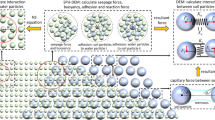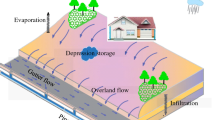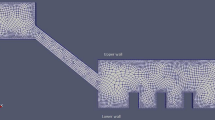Abstract
River floods can be simulated with the 2D shallow water system of equations using finite volume methods, where the terrain is discretized in cells that form the computational mesh. Usually a proper treatment of wet/dry fronts is required. River levees can be modelled as part of the topography by means of sufficiently small cells of higher elevation than the rest of the bed level in locally refined meshes. This procedure is associated with a large computational time since the time step depends directly on the cell size. The alternative proposed in this work includes the levees as internal boundary conditions in the 2D numerical scheme. In particular, levees have been defined by a weir law that, depending on the relative values of water surface levels on both sides, can formulate the discharge for different situations (i.e. free flow and submerged flow). In addition, having identified numerical difficulties in cases of low discharge under free flow conditions, a novel procedure to avoid oscillations has been developed and called volume transport method. The validation and comparison between methods has been carried out with benchmark test cases and, in addition, with a real flood event in the Ebro River (Spain)










Similar content being viewed by others
References
Arcement GJ, Schneider VR (1984) Guide for selecting Manning’s roughness coefficients for natural channels and flood plains, 2339 U.S. Geological Survey (Water Supply paper)
Chanson H (2004) Hydraulics of open channel flow. Butterworth-Heinemann, Oxford
Caviedes-Voullieme D, Garcia-Navarro P, Murillo J (2012) Influence of mesh structure on 2D full shallow water equations and SCS curve number simulation of rainfall/runoff events. J Hydrol 448:39–59
Di Baldassarre G, Casterllarin A, Brath A (2009) Anlaysis of the effects of levee heightening on flood propagation: example to the River Po, Italy. Hydrol Sci J 54(6):1007–1017
González-Sanchís M, Murillo J, Latorre B, Comín F, García-Navarro P (2012) Transient two-dimensional simulation of real flood events in a mediterranean floodplain. J Hydraul Eng ASCE 138(7):629–641
Henderson FM (1966) Open channel flow. Macmillan series in civil engineering. McGraw-Hill, New York
Jaffe DA, Sanders BF (2001) Engineered levee breaches for flood mitigation. J Hydraul Eng 127(6):471–479
Leveque R (2002) Finite volume methods for hyperbolic problem. Cambridge University Press, New York
Murillo J, García-Navarro P, Burguete J, Brufau P (2007) The influence of source terms on stability, accuracy and conservation in two-dimensional shallow flow simulation using triangular finite volumes. Int J Numer Methods Fluids 54(5):543–590
UK Environmental Agency (2010) Benchmarking of 2D hydraulic modelling packages, Environment Agency Report
Morales-Hernández M, Murillo J, García-Navarro P (2013) The formulation of internal boundary conditions in unsteady 2D shallow water flows: application to flood regulation. Water Resour Res 80:225–232
Morales-Hernández M, Hubbard ME, García-Navarro P (2014) A 2D extension of a large time step explicit scheme (CFL \(>\) 1) for unsteady problems with wet/dry boundaries. J Comput Phys 263:303–327
Remo JWF, Carlson M, Printer N (2012) Hydraulic and flood-loss modelling of levee, floodplain, and river management strategies, Middle Mississippi River USA. Nat Hazards 61:551–575
Schubert JE, Sanders BF, Smith MJ, Wright NG (2008) Unstructured mesh generation and landcover-based resistance for hydrodynamic modelling of urban flooding. Adv Water Resour 31:1603–1621
Villemonte JR (1947) Submerged-Weir discharge studies. Engineering News Record
Acknowledgements
This work was partially funded by the MINECO/FEDER under research Project CGL2015-66114-R and by Diputacion General de Aragon, DGA, through Fondo Europeo de Desarrollo Regional, FEDER. The third author also wants to thank to the MINECO for his Research Grant DI-14-06987.
Author information
Authors and Affiliations
Corresponding author
Additional information
Publisher's Note
Springer Nature remains neutral with regard to jurisdictional claims in published maps and institutional affiliations.
Rights and permissions
About this article
Cite this article
Echeverribar, I., Morales-Hernández, M., Brufau, P. et al. Use of internal boundary conditions for levees representation: application to river flood management. Environ Fluid Mech 19, 1253–1271 (2019). https://doi.org/10.1007/s10652-018-09658-6
Received:
Accepted:
Published:
Issue Date:
DOI: https://doi.org/10.1007/s10652-018-09658-6




